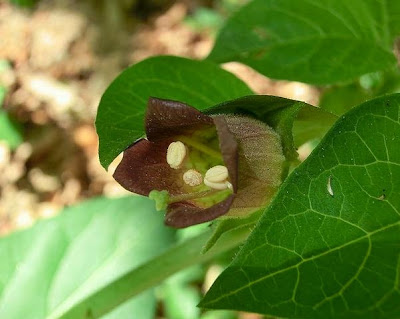Type of Flower
Atropa belladonna:
Atropa belladonna or Atropa bella-donna, commonly known as Belladonna or Deadly Nightshade, is a perennial herbaceous plant in the family Solanaceae, native to Europe, North Africa, and Western Asia. The foliage and berries are extremely toxic, containing tropane alkaloids. These toxins include scopolamine and hyoscyamine, which cause a bizarre delirium and hallucinations and are also used as pharmaceutical anticholinergics. The drug atropine is derived from the plant.
It has a long history of use as a medicine, cosmetic, and poison. Before the Middle Ages, it was used as an anesthetic for surgery; the ancient Romans used it as a poison (the wife of Emperor Augustus and the wife of Claudius both were rumored to have used it for murder); and, predating this, it was used to make poison-tipped arrows. The genus name Atropa comes from Atropos, one of the three Fates in Greek mythology, and the name "bella donna" is derived from Italian and means "beautiful woman" because the herb was used in eye-drops by women to dilate the pupils of the eyes to make them appear seductive.
Atropa belladonna is a branching herbaceous perennial, often growing as a subshrub, from a fleshy rootstock. Plants grow to 1.5 metres (4.9 ft) tall with 18 centimetres (7.1 in) long ovate leaves. The bell-shaped flowers are purple with green tinges and faintly scented. The fruits are berries, which are green, ripening to a shiny-black, and approximately 1 centimetre (0.39 in) in diameter. The berries are sweet and are consumed by animals (see Toxicity) that disperse the seeds in their droppings, even though the seeds contain toxic alkaloids.There is a pale-yellow flowering form called Atropa belladonna var. lutea with pale-yellow fruit.
Atropa belladona is rarely used in gardens, but, when grown, it is usually for its large upright habit and showy berries.It is naturalized in parts of North America, where it is often found in shady, moist locations with limestone-rich soils. It is considered a weed species in parts of the world, where it colonizes areas with disturbed soils.Germination of the small seeds is often difficult, due to hard seed coats that cause seed dormancy. Germination takes several weeks under alternating temperature conditions, but can be sped up with the use of gibberellic acid.The seedlings need sterile soil to prevent damping off and resent root disturbance during transplanting. This plant is a sign of water nearby.




















No comments:
Post a Comment